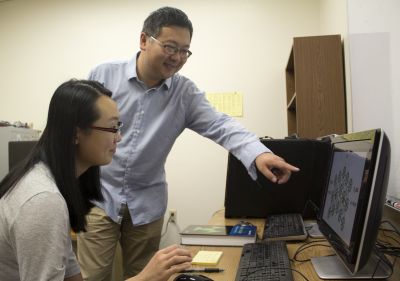The University of Nevada, Reno's new, user-driven, high-performance computing cluster will boost research capacity and better support the latest research applications such as artificial intelligence, machine learning, robotics, computational biology, computational neurosciences, bioinformatics and big data.
The significant new cluster will offer 30 times more computing power than the University's existing, high-performance system. It will put the University's computing infrastructure among those in place at many of the nation's leading research institutions.
The project funding is supported by the University along with funding through the State of Nevada Knowledge Fund, which is facilitated by the Governor's Office for Economic Development and awarded to the Nevada Center for Applied Research (NCAR), and a donation from long-time University supporter and groundbreaking researcher Mick Hitchcock.
To drive the technology and research advancement, the University partnered with Switch, a global technology company and leader in the design and operation of advanced data centers. Switch is providing more than $3.4 million in critical technology infrastructure support services through space, power and security for five years at Switch TAHOE RENO, The Citadel Campus.
"High-performance computing is critical for modern research and scientific discovery," University President Marc Johnson said. "The impact of this will be multi-dimensional; it will allow for faster analysis and exchange of large scientific datasets. It will contribute to deeper discovery across a range of research disciplines University-wide, and to development of industry partnerships."
"Making Nevada the most connected state and driving economic development through technology and data analytics are critical priorities that Switch shares with the University of Nevada, Reno," Switch Executive Vice President for Strategy Adam Kramer said. "This collaborative project will cement the University's commitment to strengthen its status as a top-level research university and its ability to partner with the private sector."
"We are again seeing individuals, organizations and industry pull together to enhance the capabilities of the University, our faculty and students, and our region's economy," Johnson said. "The involvement of Switch sets the foundation, and project support through GOED and Dr. Hitchcock further demonstrates a shared vision to advance the global competitiveness of Nevada."
Known as Pronghorn, the new research-computing cluster is named after the American antelope, the fastest mammal on the North American continent. It is expected to be available for beta-use in late fall 2017 and fully implemented by January 2018. It will be centrally managed by the Office of Information Technology, and the University's Nevada Center for Applied Research will coordinate industry access.

Advancing the computational materials-science research of Qi An, assistant professor in Chemical & Materials Engineering, shown here with Research Assistant Xiaokun Yang, is one example of Pronghorn’s impact.
Pronghorn will have impact across the fields of research and scholarship, from the natural and social sciences, to the technology, scientific, engineering and mathematics fields.
"As we began to talk about this, faculty from across many disciplines came together to say this is what we need," Mridul Gautam, University vice president for research and innovation, said. "Increasing our computational and modeling capability will allow faculty to better exchange, analyze and store data, and more effectively collaborate on an international scale through tools such as high-definition video conferencing."
Faculty members are involved in the development and governance of Pronghorn.
"Researchers are driving the hardware and software specification decisions with input from IT, rather than the other way around. This is a new paradigm for this University," Jeff LaCombe, associate professor of chemical and materials engineering and chair of the faculty-based Cyberinfrastructure Committee, said.
"Some big-data projects require large-scale memory while others require high-speed networks," LaCombe said. "We are looking to balance both."
Incorporating input from the Cyberinfrastructure Committee, the University's Office of Information Technology identified Dell EMC as the vendor for system hardware that will allow advanced applications and high-speed connectivity.
"The idea is to build an infrastructure with enough capacity so we have what we need with additional 'head room' for future development," Steve Smith, University vice provost and chief information officer, said.
The Cyberinfrastructure Committee is now focused on governance issues such as how use of Pronghorn will be scheduled and prioritized. Pronghorn is being built on a sustainable model successfully deployed by other research institutions, with researchers opting to invest funding in the computing infrastructure to reserve prioritized access while also supporting future development.
NCAR will coordinate industry access when a tangible connection to the University, such as a research collaboration, is demonstrated. Also supported through GOED, NCAR is the applied research-and-development-technology center that makes the facilities, equipment and talent of the University available to industry through customized, fee-for-service contracts.
"Each of the partners behind this initiative understands that investment of their talent or resources in our infrastructure - in this case, our high-end computing infrastructure - will be leveraged in many ways," Gautam said. "This is a tangible milestone toward this University's commitment to continue to enhance the research enterprise."
Project funding of Pronghorn is further supported by the University's Research & Innovation division and Office of Information Technology.












